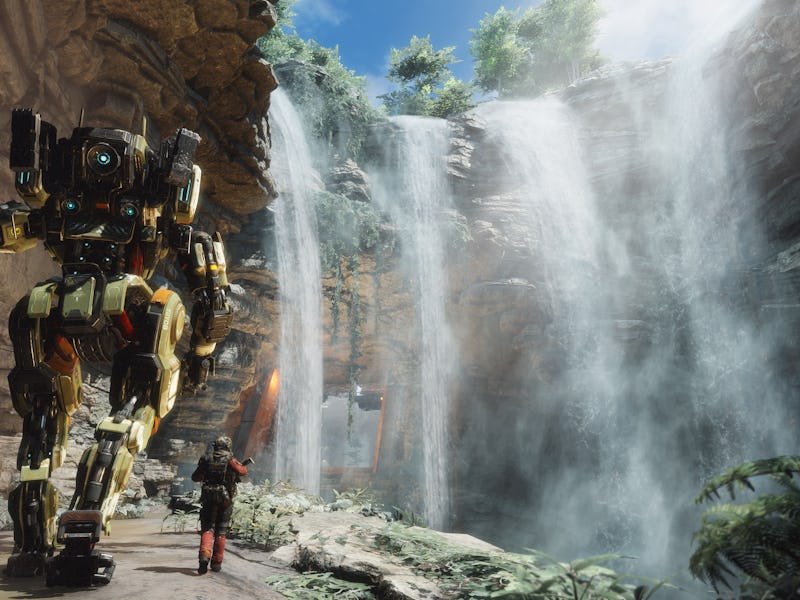The New ‘Titanfall 2’ Titans Are Exactly What Players Wanted
Respawn Entertainment's approach to giant battle mechs is much better this time around.

Respawn Entertainment is clearly working to change the simple ‘Titan triangle’ of rock-paper-scissors that was present in the first game with six new Titan classes in the upcoming Titanfall 2. They’re heavily customized versions of the original three, which revolve around certain loadouts and gameplay mechanics. Which is pretty much exactly what players wanted all along.
Each of these new classes also focuses around a specific type of weaponry, giving players access to a loadout of three abilities, a unique primary weapon, and a core ability like the Titans from the first game. The real difference this time around? They’ve got a hell of a lot more character — and that’s a damn good thing.
When Respawn released Titanfall in 2014, it received a mixed reception, namely due to the lack of a single player campaign. There was also lack of depth when it came to the multiplayer as well. The mode was fleshed out as time went on, but not by initial release.
Despite numerous patches and free content drops for players, this consistent problem remained with at least one core aspect of Titanfall though: the Titans themselves.
In Titanfall, these advanced battle mechs serve as one of the key pillars to gameplay. Not only do they help fulfill everyone’s dream of piloting a giant robot, but they function as an alternative to running around and gunning — they are what makes Titanfall stand out from other shooters. But the problem with the original game is that Titans didnt work to serve a player’s personal approach to combat, opting instead to follow the path of speed, damage, or defense.
This oversimplification of an otherwise interesting gameplay mechanic led to matches where everyone would pick a Titan that didn’t have much of an impact in-game. Sure, you were able to utilize your core abilities to save yourself from danger or dash around the map quickly with extra boost storage, but when it came to the rest of your loadout nothing felt unique about your giant battle robot — a problem that carried years past release.
During the pre-alpha tech test this past weekend, we had a chance to play with two of the new Titan classes Respawn’s added to Titanfall 2 seemingly in order to combat this problem directly.
The first of these was the Ion class, a heavily modified version of the Atlas chassis from the first game. The Ion class revolves entirely around energy weaponry, providing players with a balanced kit for both offensive and defensive actions. Your primary weapon in an Ion is the Splitter rifle, a direct energy weapon that operates like an assault rifle when fired normally and spreads out into a flat line of fire when you aim down the sights. You’ll also get access to the vortex shield which absorbs damage, the laser shot which is a single-shot laser beam, and a tripwire that deals damage to those who walk across it. Each of these abilities also charges your core when used efficiently — which gives you access to an Iron Man-like chest laser that can decimate enemy dropships and Titans.
The second of the new Titan classes was the Scorch class, which is a modified version of the Ogre chassis from the first game. This Titan class revolves around incendiary weaponry, which can be used to lock down specific areas of the battlefield and deal massive amounts of damage over time. Your primary weapon in a Scorch is the T-203 Thermite Launcher, a single-shot canon that impacts an enemy and burns into them to deal damage over a brief amount of time. You’ll also get access to a firewall which can place down a line of incendiary damage, a heat shield which melts incoming fire to charge your core, and an incendiary trap that disperses gas over an area you can set on fire for massive amounts of damage. Your core ability, which is charged by all of your other abilities, is a giant ground pound that releases a cone of fire in front of your dealing massive damage to anything in the way.
Both the Ion and Scorch chassis felt extremely versatile compared to their counterparts in the original Titanfall, allowing players to work with their abilities in order to control the battlefield. Throughout all of my matches, I found myself consistently switching between the two depending on what my team needed in order to control the map or to eliminate enemy Titans. Each set of abilities felt like it was necessary in order to combat a specific team composition, although we were certainly limited in our choices for the testing period.
Honestly, the idea of creating Titan chassis that revolve around a specific mechanic sounds boring compared to customizing their loadouts yourself, but the result of such a decision has created a solution to the simplicity of the original Titanfall. This time around, a Titan feels unique compared to the other classes you’ll go up against and has certain advantages and weaknesses you’ll have to learn to master. It’s a huge step forward in the right direction for Titanfall 2, but one we wont fully be able to judge until the full game releases with all six Titan classes.